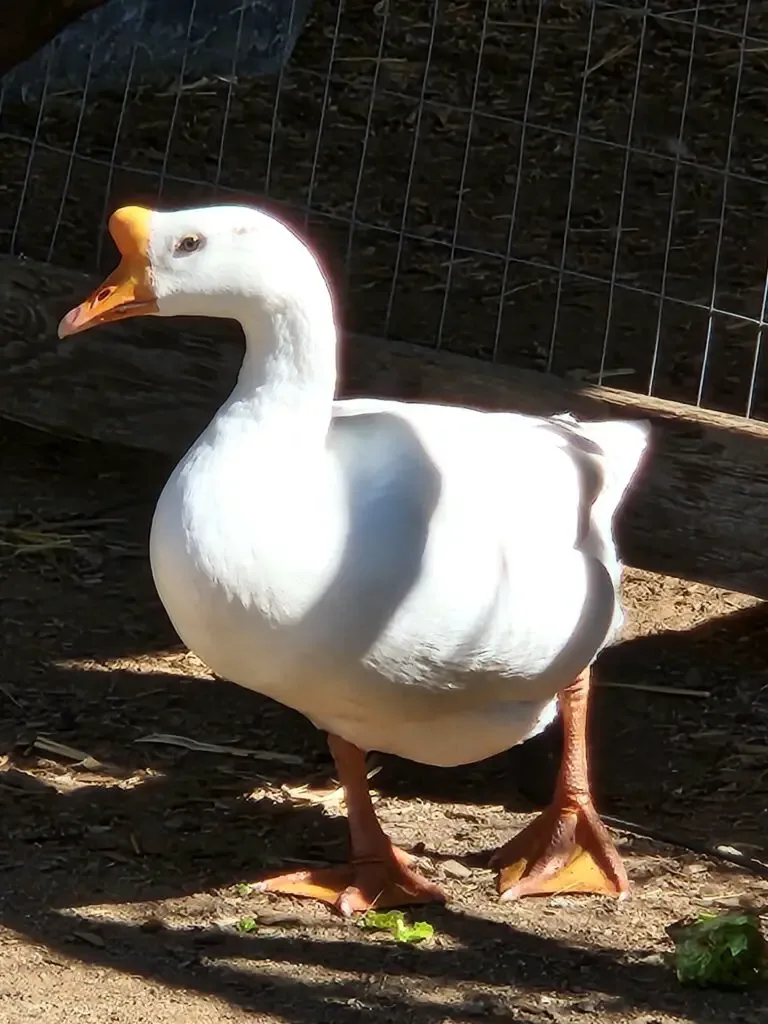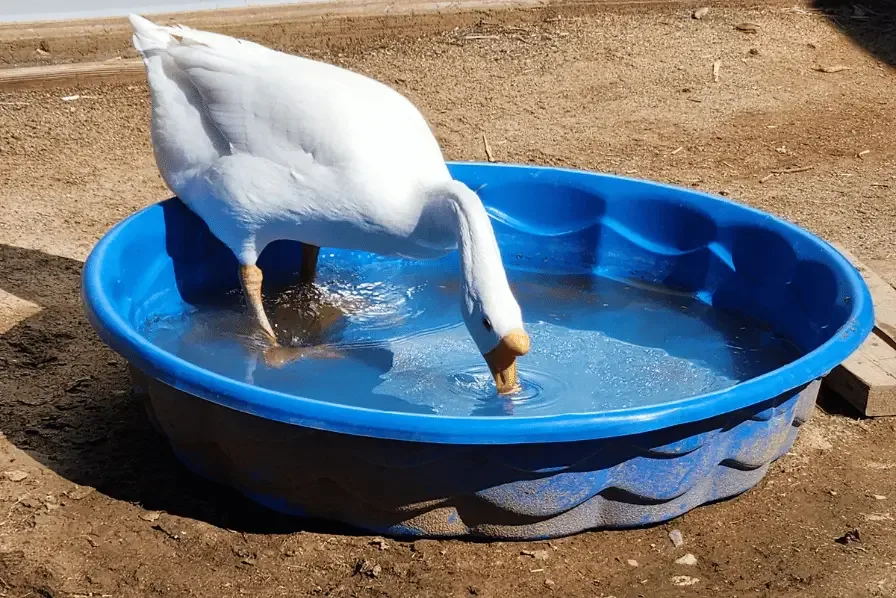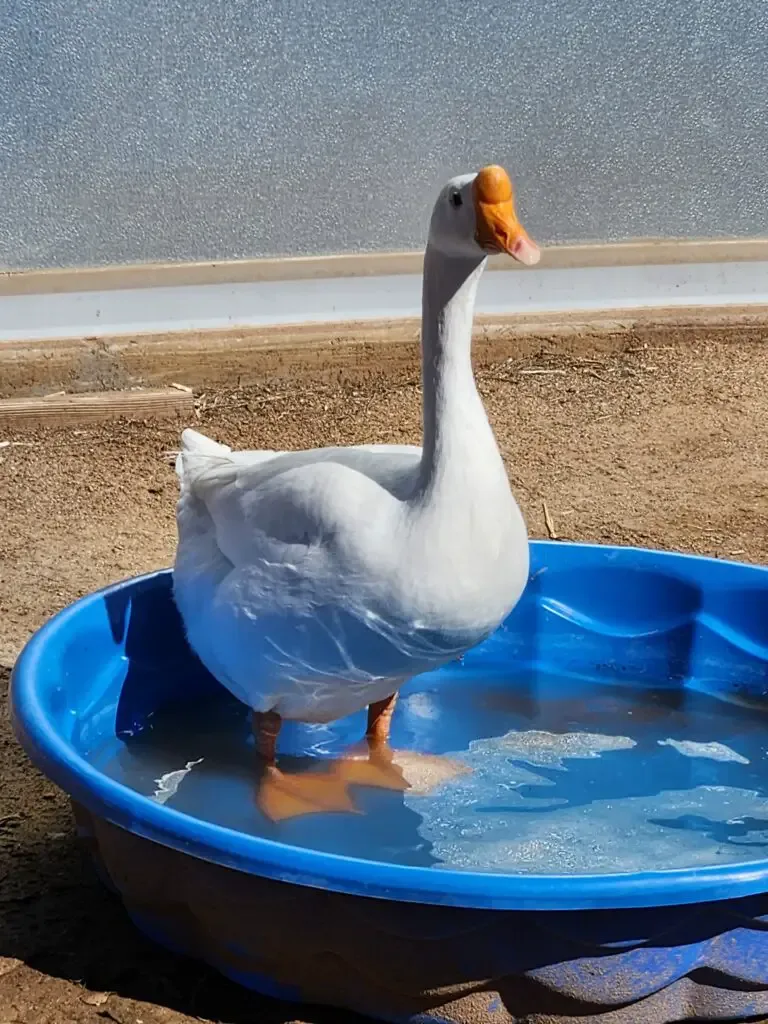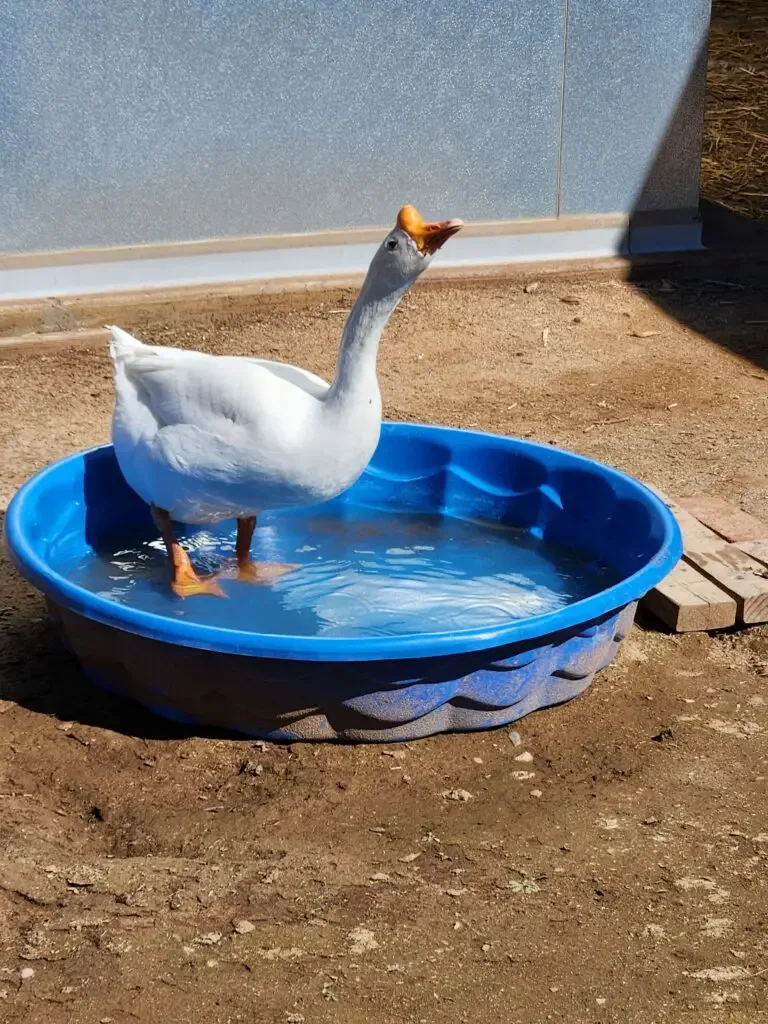Chinese geese, also known as Swan Geese, are a domesticated breed of waterfowl originating from China.
They are considered one of the oldest domesticated geese breeds, with a history dating back over 2,000 years.
Chinese geese are highly valued for their meat, eggs, and feathers, and have been raised by farmers for centuries.
In this post, we will discuss:
- Their origins and history
- Physical and behavioral characteristics of this breed
- How to feed and care for them
- Frequently asked questions

Chinese Goose Overview
| Lifespan | 10-12 years |
| Weight | Female: 8-10 lbs, Male: 10-12 lbs |
| Appearance | Brown/Gray or white feathers |
| Egg Color | White |
| Egg Size | Extra large |
| Egg Production | 30-50 per year |
| Broodiness | Medium |
| Beginner Friendly | Medium |
| Space Needed | 15-20 square foot per bird |
| Price | $10-$30 per gosling |
Origins and History
Chinese geese, also known as Anser cygnoides, are a domesticated breed of waterfowl that have their origins in Asia, specifically in China.
They are believed to be descendants of the wild swan goose, which is native to China and other parts of Asia.
Chinese geese have also been domesticated for thousands of years, with evidence of their domestication dating back to at least 1,000 B.C. in China.
They were mostly bred for their meat, eggs, and feathers.
However, they were also sometimes used as guard animals due to their loud honking calls.
Surprisingly, Chinese geese were brought to the United States in the late 1700s by none other than George Washington himself.
He imported them to his estate at Mount Vernon, where they were used as guard animals and for their meat and feathers.
Today, this breed can be found in many parts of the world, including the United States, where they continue to be valued for their meat, eggs, and feathers, as well as for their unique personalities and beauty.

Physical Characteristics
Chinese geese are a domesticated breed of goose that is popular for their unique appearance and gentle temperament.
They are medium-sized waterfowl that have several distinctive features that set them apart from other breeds of geese.
Color Varieties
Chinese geese come in a variety of colors, including:
- White
- Brown
- And a combination of both
They are also known for having a distinctive knob on their forehead, which is more pronounced in males than in females.
This knob can be any color, but it is usually orange or red.
Distinctive Features
In addition to their knob, Chinese geese are known for their slender and thin necks, which give them a graceful appearance.
They also have a basal knob at the base of their neck, which is much smaller than the knob on their forehead and either orange or red webbed feet.
Brown Chinese geese oftentimes have black bills and blue eyes.
Size and Stature
Chinese geese are medium-sized birds that typically weigh between 8 and 12 pounds.
They are known for their upright posture and long, slender necks.
They have a sleek and streamlined appearance, which makes them popular for ornamental purposes.

Behavior and Temperament
They are highly social birds and prefer to live in groups.
They form strong bonds with their mates and can become aggressive towards other geese if they feel threatened or if their mate is in danger.
Chinese geese are also known to be protective of their young and will fiercely defend them against predators.
This breed is also very vocal and they use a variety of calls to communicate with each other.
They make a loud honking sound when they feel threatened or when they are warning other members of their flock about potential danger.
They also use a soft hissing sound to communicate with their mates and young.
Chinese geese are very responsive to their owners and will often honk or hiss in recognition of their presence.
However, they can be aggressive towards humans and other animals if they feel threatened or if they feel that their territory is being invaded.
They are known to be good watchdogs and will alert their owners to the presence of strangers.
But they can become overly aggressive if they are not properly socialized or if they are mistreated.
It is important to handle Chinese geese with care and to provide them with a safe and secure environment.

Breeding and Reproduction
Mating Habits
Chinese geese are monogamous and form long-lasting bonds with their mates.
The breeding season for these birds typically begins in late winter or early spring, with males becoming increasingly vocal and territorial.
During mating, the male will mount the female from behind and hold onto her neck with his beak.
Egg Laying Patterns
Chinese geese are prolific egg layers, with females typically laying between 30-50 extra large eggs per year.
The egg-laying season typically begins in late winter or early spring and can last until early summer.
These geese are known to lay their eggs in a variety of locations, including in nests made from grass and other materials or in natural depressions in the ground.
They are also known to lay their eggs in communal nests with other geese.
Gosling Care
Once the eggs hatch, both the male and female Chinese geese take an active role in caring for their goslings.
Goslings are precocial, meaning they are able to move around and feed themselves shortly after hatching.
These birds are protective parents, and will fiercely defend their young against predators.
During the breeding season, they may become aggressive towards humans or other animals that they perceive as a threat to their young.
It is important to give them plenty of space and avoid disturbing their nests or goslings.
Dietary Needs
Feeding Practices
Chinese geese have a unique feeding habit, as they are primarily grazers, unlike other domesticated geese that are known to be more omnivorous.
Grazing is a feeding practice in which the geese consume grasses and weeds throughout the day.
They prefer to graze in open fields and pastures, where they can easily access their preferred foods.
This goose breed is known to be active grazers, spending most of their day in search of food.
They are also known to be selective grazers, meaning they have a preference for certain types of grasses and weeds.
Preferred Foods
Chinese geese have a diverse diet that consists mainly of grasses and weeds.
They prefer to consume young, tender grasses that are low in fiber and high in protein.
Some of the grasses that they prefer include:
- Clover grass
- Timothy grass
- Bermuda grass
Apart from grasses, Chinese geese also enjoy consuming weeds such as dandelions, chickweed, and plantain.
They also like to consume fruits and vegetables, but these should not be the primary component of their diet.
It is important to note that these geese require a balanced diet to maintain their health and well-being.
A diet that is deficient in nutrients can lead to health problems such as poor feather quality, reduced egg production, and weakened immune systems.
Therefore, it is essential to provide them with a diet that meets their nutritional needs.

Final Thoughts
Overall, Chinese geese are a unique and interesting breed of waterfowl that are known for their distinctive appearance and gentle temperament.
They are a popular choice for backyard farmers and hobbyists who are looking for a beautiful and easy-to-care-for bird.
They are also a popular choice for homesteaders and small-scale farmers, as they are excellent foragers and can provide a sustainable source of meat and eggs.
These birds are also known for their watchful and protective nature, and their ability to form strong bonds with their owners.
With proper care and attention, these beautiful birds can make wonderful companions for years and years.
Frequently Asked Questions
How can you differentiate between male and female Chinese geese?
It can be difficult to differentiate between male and female Chinese geese, especially when they are young.
However, once they reach maturity, some physical differences can help distinguish between the two.
For instance, male Chinese geese tend to be larger in size and have a more prominent knob on their beak.
They also tend to have a louder honk compared to females.
Females, on the other hand, have a slightly smaller body size and a less pronounced knob on their beak.
When do Chinese geese start laying eggs?
Chinese geese start laying eggs around 4 months of age.
What is the average lifespan of Chinese geese?
The average lifespan of Chinese geese is around 10-12 years.
However, with proper care and nutrition, some this breed has been known to live up to 20 years.
Do Chinese geese migrate seasonally?
Chinese geese have yet to be known to migrate seasonally.
They are domesticated birds that are typically raised on farms or in backyard settings.
What are the primary uses of Chinese geese in agriculture or domestically?
Chinese geese are primarily used for their meat and eggs.
Their meat is considered to be of high quality and is often used in traditional Chinese dishes.
Their eggs are also highly valued and are used in a variety of culinary preparations.
What are the advantages of raising Chinese geese?
There are several advantages to raising Chinese geese.
They are hardy birds that are easy to care for and can thrive in a variety of different environments.
They are also excellent foragers and can help control pests in gardens and other agricultural settings.
Additionally, their meat and eggs are highly valued and can provide a source of income for farmers and backyard enthusiasts.
Can Chinese geese be found in the wild in America?
Chinese geese are not native to America and are not typically found in the wild.
However, they are commonly raised on farms and in backyard settings throughout the country.
Related Posts

